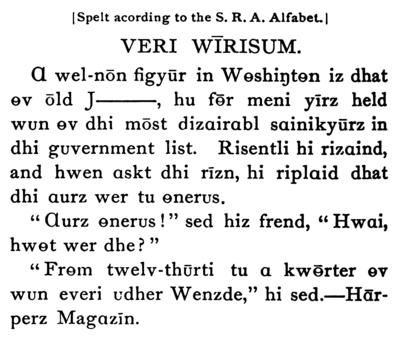« Spelling Reform Association » : différence entre les versions
| Ligne 12 : | Ligne 12 : | ||
Fichier:Alphabet of the Spelling Reform Association, 1877 revision.png|Alphabet de la SRA en juillet 1877. |
Fichier:Alphabet of the Spelling Reform Association, 1877 revision.png|Alphabet de la SRA en juillet 1877. |
||
Fichier:Spelling Reform Association alfabet in The Phonographic Magazine, vol 5, no. 7, July 1891, p. 224.png|Texte avec l’alphabet de la SRA dans ''The Phonographic Magazine'' de juillet 1891. |
Fichier:Spelling Reform Association alfabet in The Phonographic Magazine, vol 5, no. 7, July 1891, p. 224.png|Texte avec l’alphabet de la SRA dans ''The Phonographic Magazine'' de juillet 1891. |
||
Fichier:Spelling Reform Association Fonetic Alfabet in Spelling, December 1931, vol. 2, nr. 4, p. 50.jpg|thumb|Le ''Fonetic Alfabet'' de la SRA, dans ''Spelling'', décembre 1931. |
Fichier:Spelling Reform Association Fonetic Alfabet in Spelling, December 1931, vol. 2, nr. 4, p. 50.jpg|thumb|Le ''Fonetic Alfabet'' de la SRA, dans ''Spelling'', décembre 1931. |
||
</gallery> |
</gallery> |
||
Version du 29 mai 2022 à 07:54
La Spelling Reform Association (SRA, « Association pour la réforme de l’orthographe » en anglais) est une organisation américaine pour la promotion d’une réforme de l’orthographe anglaise, créée en aout 1876 lors de la convention pour la modification de l’orthographe anglaise tenue à Philadelphie aux États-Unis. Une association équivalente est créée au Royaume-Uni en 1879. La Simplified Spelling Board dirigée par Melvil Dewey, créée en 1906 aux États-Unis, et la Simplified Spelling Society créée en 1908 au Royaume-Uni, prirent la relève de leurs efforts de réforme.
La SRA publie son journal Bulletin of the Spelling Reform Association dans les années 1870 et 1880, celui-ci est ensuite nommé Spelling et est publié conjointement avec la Simplified Spelling Board et la Simplified Spelling Society.
Alphabet
L’alphabet phonétique pour l’anglais de la SRA est conçu lors de la convention de 1876, inspiré de l’alphabet phonotypique d’Alexander John Ellis et Isaac Pitman, et des alphabets phonétiques de W. W. Skeat, de E. Jones en Angleterre, et d’Eliza Boardman Burnz (en), de David Philip Lindsey et J. W. Shearer aux États-Unis[1],[2].
Un nouvel alphabet développé par l’American Philological Association est ensuite adoptée la SRA[3].
-
Alphabet de la SRA en juillet 1877.
-
Texte avec l’alphabet de la SRA dans The Phonographic Magazine de juillet 1891.
-
Le Fonetic Alfabet de la SRA, dans Spelling, décembre 1931.
Notes et références
Sources
- (en) Frederik A. Fernald (dir.), Our language: a jurnal of spelling reform and uther language topics, vol. 1-3, 1891-1894 (lire en ligne)
- (en) Thɛ Jurnɑl ɵv ɷrthoɛpi & ɷrthɵgrɑfi [The Journal of Orthoepy and Orthography], vol. 23-24, Ringoes (New Jersey), C. W. Larison, 1906-1907 (lire en ligne)
- (en) O. C. Blackmer, Pronɑunsing Bɑibl : Gɵspel acɵ̂rding tu Mɑ̂rc, Oak Park, Ill., O. C. Blackmer, (lire en ligne)
- (en) C. W. Larison, Sɵlomɵn’z sɵŋ with introdʊcshʊn and nots, Ringoes (New Jersey), Fonic Publishiŋ Hɵus, (lire en ligne)
- (en) C. W. Larison, Reminissensez ɵv scɯl lɨf, Ringoes (New Jersey), Fonic Publishiŋ Hɵus, (lire en ligne)
- (en) Francis Andrew March, The Spelling Reform, (lire en ligne)
- (en) Spelling Reform Association, « International convention for the amendment of the English orthography », dans Bulletins of the Spelling Reform Association, from 1877 to 1880, , 1-30 p. (lire en ligne)
- (en) Thomas Rhys Vickroy, A Phonetic First Reader, Cincinnati, New York, Van Antwerp, Bragg & Co., (lire en ligne)
- (en) Thomas Rhys Vickroy, Phonetic Teacher, vol. 2, St. Louis, Thomas Rhys Vickroy, (lire en ligne)
- (en) Thomas Rhys Vickroy, Phonetic Teacher, vol. 4, St. Louis, Thomas Rhys Vickroy, (lire en ligne)
- (en) Thomas Rhys Vickroy, Buletinz ov the Speling reform asoshiashun, from 1877 tu 1880. Colected, completed and baund bai T. R. Vicroi., St. Louis, (lire en ligne)



